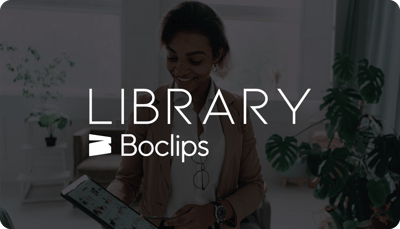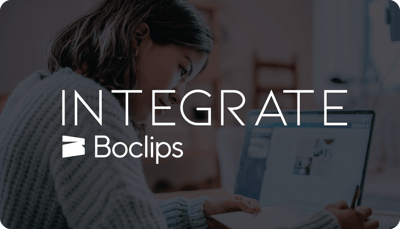Boclips recently met with three educators from various backgrounds to discuss how to use videos to drive educational engagement at all levels. In “How to use video to drive engagement from learners at all levels,” we learn how educators strive to drive student engagement and how they make sure that the needs of all students are being met.
Watch the full webinar here, or keep reading for a recap.

Meet our speakers:
Register for Boclips Classroom for free to watch videos from these three educational creators.

Caroline Farkas, Creator of Doodles and Digits and former K-5 educator. Watch Doodles and Digits content on Boclips Classroom. Contact Caroline at caroline[at]doodleslearning.com

Tatum Rijper, head of FuseSchool and former 6-8 educator. Watch FuseSchool content on Boclips Classroom. Contact Tatum at info[at]fuseschool.org.

Matt Beat, creator of Mr. Beat and former 7-12 educator. Watch Mr. Beat content on Boclips Classroom. Contact Mr. Beat at iammrbeat[at]gmail.com.
What is differentiated instruction?
Not all students are starting from the same level of understanding or education. Part of being an educator is understanding different ways to reach students where they are at – however different that might be from one another. This is where differentiated instruction is key for enhancing educational forums.
Before diving into differentiated instruction, it helps to understand what is meant by differentiation. “Differentiation is basically understanding that there are different styles for different students in which everyone can learn,” says Tatum, Head of FuseSchool. “As teachers, we need to be able to facilitate the learners in our class in a way that matches their style of learning - some are auditory, some are visual, and some are kinesthetic. So what do we do as teachers to facilitate that learning style, to make sure that in the diversity of the classroom, diverse learning is taking place?”
One way is to recognize that each student enters learning from different starting points. “Not everybody takes into consideration the starting point because we only think of the end goal. The experience that a child needs to have for the time period that they're in the classroom is what matters most if you are actually looking for success. And it starts where that child is at,” according to Tatum.

How can you meet differentiation needs?
Meeting each child where they’re at requires personalization. What was once incredibly difficult to achieve by way of personalization, is now a bit easier due to technology. Nearly every student has a device, which is essentially a one to one learning machine. “There are so many tools for teachers now…It's so cool that we are now in an age where there is one to one,” says Caroline Farkus, Founder of Doodles and Digits. “Teachers do have the flexibility to supplement and do all of these cool things with videos and technology.”
Technology is improving so much of education around the world that teachers can cultivate and create programs using videos. And though they agree that videos shouldn’t be the primary educational tool, each of our educators say videos can do the job. “Research shows that you can learn just as much from videos as you can from reading, which is amazing. But, I think the best form of teaching still is one-to-one in person, with back and forth. Often, the only reason why the student is listening is because they have this relationship with the teacher. They respect the teacher,” according to Matt Beets, American Political History Teacher and online presence.

What types of videos keep students engaged?
Curating educational videos as a means of reaching more students is an amazing asset. However, there are a few things to keep in mind for finding what will work for students at all levels. Here are a few tips shared in this webinar:
Pay attention to time: Students lose interest after a certain number of minutes. Attention spans are limited, especially for more technical topics. So, ensure that even the most complex topics can be covered in a shorter window of time. Moreover, find content that isn’t presented too quickly and can highlight important elements through sounds, shapes, and colors. “There is research to suggest that when you teach a brand new term that students aren’t used to hearing in everyday vocabulary, put it on the screen. Just show it visually, even for a few seconds. It's more likely to stick to their brain.”
Use evergreen content: The content of any educational video is the most important priority. Will this information ring true not only in the present but also in the future? “It's super important to understand when you select videos that it needs to be as inclusive as possible for your classroom and that the content should be evergreen instead of thinking of what is going to be cool next year. Just think of the content and then build around that. And luckily for us, there's so much you can do with video, you know, you can cut, and then you can edit in a different piece and remix it. So for teachers, it's not limited anymore,” Tatum shares.

Give students options: Not every student learns the same way, so presenting information in different formats is the most effective way to reach a larger audience. “You could be teaching the same topic and have three different creators teaching the same thing. But one might just resonate with someone more. If a student didn't get how you're teaching them in class, you can give them a couple of options so they can choose whichever one clicks for them,” says Caroline.
Repeat often: Everyone, both students and adults, retain information better and feel more prepared when repetition happens. It is an imperative part of the learning process. “How many times do we as teachers need reminders? With repetition, you get results. Engagement will improve as learners feel capable,” Tatum shares. “The ‘I don't know’ response can change to ‘let me try.’ Once I went from just talking, students who didn’t try in class became those who tried when we showed video content.”

Consider the classroom structure: There are so many ways to incorporate video - from hooks to homework and relearning work (Check out Caroline's webinar with strategies for using video to supplement curriculum). One way is to use a flipped classroom structure where students engage with material at home, and discuss it in class. One thing this style does is allow the teacher to spend valuable class time helping the students really focus in on the most difficult aspects of the material. It also creates opportunities for student engagement in-class.

Video can also be used to reteach, to kick off a lesson where students may need a refresher or parents may need support to help students.

Importance of the educator: At the end of the day, video is an incredible tool for differentiation, but it's the educator who knows exactly what that student needs that leads to the best results.

A curriculum-aligned educational video platform
Boclips Classroom has 1.7M educational videos organized by curricula, subject, level, pedagogical use case, and more. It's curated, safe, authentic, and free of ads and algorithmic recommendations. Educators get free access to Boclips Classroom- sign up here.
- #Classroom
- #Video in Digital Learning
- #Educational Videos
- #Tips for Using Video
- #Video Content Partners
- #Boclips for Publishers
- #Issues in Education
- #Educational Videos by Subject Area
- #News and Announcements
- #Events & Holidays
- #Video and Teaching Tools
- #Teaching Methodologies
- #Education Videos
- #Video and Digital Literacy
- #Short Educational Videos
- #Instructional Design
- #Multimodal Learning
- #Video and Student Safety
- #Accessibility in Education
-3.png?width=390&height=223&name=Untitled%20design%20(2)-3.png)


.png?width=1152&height=660&name=Copy%20of%20Untitled%20Design%20(1).png)


